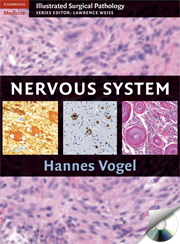Book contents
- Frontmatter
- Contents
- Contributors
- Preface
- Acknowledgments
- 1 Normal Anatomy and Histology of the CNS
- 2 Intraoperative Consultation
- 3 Brain Tumors
- Brain Tumors – An Overview
- Brain Tumor Locations with Respect to Age
- Grading Brain Tumors
- NEUROEPITHELIAL
- TUMORS OF CRANIAL AND PARASPINAL NERVES
- TUMORS OF THE MENINGES
- LYMPHOMAS AND HEMATOPOIETIC NEOPLASMS
- GERM CELL TUMORS
- NONNEOPLASTIC MASSES AND CYSTS
- PATHOLOGY OF THE SELLAR REGION
- METASTATIC NEOPLASMS OF THE CENTRAL NERVOUS SYSTEM
- SKULL AND PARASPINAL NEOPLASMS, NONNEOPLASTIC MASSES, AND MALFORMATIONS
- CNS-RELATED SOFT TISSUE TUMORS
- 4 Vascular and Hemorrhagic Lesions
- 5 Infections of the CNS
- 6 Inflammatory Diseases
- 7 Surgical Neuropathology of Epilepsy
- 8 Cytopathology of Cerebrospinal Fluid
- Index
LYMPHOMAS AND HEMATOPOIETIC NEOPLASMS
from 3 - Brain Tumors
Published online by Cambridge University Press: 04 August 2010
- Frontmatter
- Contents
- Contributors
- Preface
- Acknowledgments
- 1 Normal Anatomy and Histology of the CNS
- 2 Intraoperative Consultation
- 3 Brain Tumors
- Brain Tumors – An Overview
- Brain Tumor Locations with Respect to Age
- Grading Brain Tumors
- NEUROEPITHELIAL
- TUMORS OF CRANIAL AND PARASPINAL NERVES
- TUMORS OF THE MENINGES
- LYMPHOMAS AND HEMATOPOIETIC NEOPLASMS
- GERM CELL TUMORS
- NONNEOPLASTIC MASSES AND CYSTS
- PATHOLOGY OF THE SELLAR REGION
- METASTATIC NEOPLASMS OF THE CENTRAL NERVOUS SYSTEM
- SKULL AND PARASPINAL NEOPLASMS, NONNEOPLASTIC MASSES, AND MALFORMATIONS
- CNS-RELATED SOFT TISSUE TUMORS
- 4 Vascular and Hemorrhagic Lesions
- 5 Infections of the CNS
- 6 Inflammatory Diseases
- 7 Surgical Neuropathology of Epilepsy
- 8 Cytopathology of Cerebrospinal Fluid
- Index
Summary
MALIGNANT LYMPHOMAS
Clinical and Radiological Features
Malignant lymphomas may occur in the brain either as primary CNS lymphoma (PCNSL) or in the setting of systemic lymphoma. The incidence of PCNSL has risen dramatically in recent decades, mostly in males and at least in part attributable to the spread of acquired immunodeficiency syndrome (AIDS) (Cote et al., 1996) as well as immunocompromise due to organ transplantation but also as a more common diagnosis in the older population. In the context of immunodeficiency, Epstein–Barr virus (EBV) is associated with essentially all PCNSLs.
T-cell lymphomas are reportedly more common in some Asian countries, with the proportion of T-cell lymphomas of the CNS (T-CNSL) over 16% in Korea (Choi et al., 2003) and above 8% in Japan (Bataille et al., 2000). The reasons for these discrepancies remain unknown. The majority of T-CNSL arise in immunocompetent individuals (Louis and International Agency for Research on Cancer, 2007).
A variety of symptoms are associated with PCNSL, usually beginning with focal neurologic deficits or signs of increased intracranial pressure. The duration of symptoms vary widely but averages a few months prior to diagnosis. Transplant associated PCNSL occurs with an interval averaging between 2 and 3 years after transplantation (Penn and Porat, 1995). Ocular uveal examples may precede the later development of PCNSL (Akpek et al., 1999).
PCNSL occurs more commonly in the supratentorial compartment and has a distinct propensity for periventricular growth. Multiple lymphomas occur in 25–50% of the cases, which is particularly common in patients with AIDS. Bilateral and symmetric spread is typical.
- Type
- Chapter
- Information
- Nervous System , pp. 222 - 239Publisher: Cambridge University PressPrint publication year: 2009

